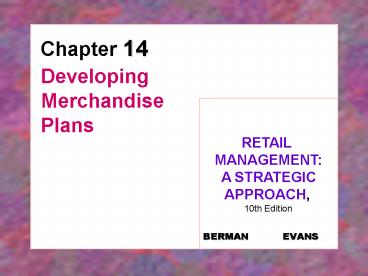Developing Merchandise Plans PowerPoint PPT Presentation
1 / 38
Title: Developing Merchandise Plans
1
Chapter 14
- Developing Merchandise Plans
RETAIL MANAGEMENT A STRATEGIC APPROACH, 10th
Edition
BERMAN EVANS
2
Chapter Objectives
- To demonstrate the importance of a sound
merchandising philosophy - To study various buying organization formats and
the processes they use - To outline the considerations in devising
merchandise plans forecasts, innovativeness,
assortment, brands, timing, and allocation - To discuss category management and merchandising
software
3
Merchandising
- Activities involved in acquiring particular goods
and/or services and making them available at the
places, times, and prices and in the quantity
that enable a retailer to reach its goals
4
Merchandising Philosophy
- Sets the guiding principles for all the
merchandise decisions that a retailer makes - Should reflect
- Target market desires
- Retailers institutional type
- Market-place positioning
- Defined value chain
- Supplier capabilities
- Costs
- Competitors
- Product trends
5
Scope of Merchandising Responsibility
- Full array of merchandising functions
- Buying and selling
- Selection, pricing, display, customer
transactions - OR
- Focus on buying function only
6
Figure 14-1 Nikes Own Store Merchandising
Philosophy
7
Micromerchandising
- Retailer adjusts shelf-space allocations to
respond to customer and other differences among
local markets
8
Cross-Merchandising
- Retailers carry complementary goods and services
to encourage shoppers to buy more
9
Figure 14-2 Attributes and Functions of
Buying Organizations
10
Functions Performed
- Merchandising view
- All buying and selling functions
- Assortments
- Advertising pricing
- Point-of-sale displays
- Employee utilization
- Personal selling approaches
11
Functions Performed (cont.)
- Buying view
- Buyers manage buying functions
- Buying
- Advertising
- Pricing
- In-store personnel manage other tasks
- Assortments
- Point-of-sale displays
- Employee utilization
- Personal selling approaches
12
Figure 14-4 Merchandising Versus Store
Management Career Tracks
13
Figure 14-5 Devising Merchandise Plans
14
Forecasts
- These are projections of expected retail sales
for given periods - Components
- Overall company projections
- Product category projections
- Item-by-item projections
- Store-by-store projections (if a chain)
15
Types of Merchandise
- Staple merchandise
- Assortment merchandise
- Fashion merchandise
- Seasonal merchandise
- Fad merchandise
16
Staple Merchandise
- Regular products carried by a retailer
- Grocery store examples milk, bread, canned soup
- Basic stock lists specify inventory level, color,
brand, style, category, size, package, etc.
17
Assortment Merchandise
- Apparel, furniture, auto, and other categories
for which the retailer must carry a variety of
products in order to give customers a proper
selection - Decisions on Assortment
- Product lines, styles, designs, and colors are
projected - Model stock plan
18
Fashion and Seasonal Merchandise
- Fashion Merchandise Products that may have
cyclical sales due to changing tastes and
life-styles - Seasonal Merchandise Products that sell well
over nonconsecutive time periods
19
Table 14-1a Factors in Planning Merchandise
Innovativeness
20
Table 14-1b Factors in Planning Merchandise
Innovativeness
21
Table 14-1c Factors in Planning Merchandise
Innovativeness
22
Figure 14-6 RD at Wendys
23
Figure 14-7 Traditional Product Life Cycle
24
Structured Guidelines for Pruning Products
- Select items for possible elimination on the
basis of declining sales, prices, and profits,
appearance of substitutes - Gather and analyze detailed financial and other
data about these items - Consider nondeletion strategies such as cutting
costs, revising promotion efforts, adjusting
prices, and cooperating with other retailers - After making a deletion decision, do not overlook
timing, parts and servicing, inventory, and
holdover demand
25
Figure 14-8 Predicting Fashion Adoption
26
Table 14-2a Factors in Planning Merchandise
Quality
27
Table 14-2b Factors in Planning Merchandise
Quality
28
Table 14-2c Factors in Planning Merchandise
Quality
29
Retail Assortment Strategies
Width of assortment refers to the number of
distinct goods/service categories (product lines)
a retailer carries Depth of assortment refers to
the variety in any one goods/service category
(product line) a retailer carries An assortment
can range from wide and deep (department store)
to narrow and shallow (box store)
30
Figure 14-10 Sephoras Very Deep Assortment of
Cosmetics
31
Brands
Manufacturer (national)
Private (dealer or store)
Generic
32
Table 14-3 Private Brand Test Match the
Retailer with the Brand Name
33
Figure 14-11 Wal-Marts New Approach to Private
Brands
34
Figure 14-12 Daffys Distinctive Branding
Strategy
35
Figure 14-13 Applying Category Management
36
Merchandising Software
- General Merchandise Planning Software
- Forecasting Software
- Innovativeness Software
- Assortment Software
- Allocation Software
- Category Management Software
37
Figure 14-4a Shelf Logic Software for Category
Management Planning
38
Figure 14-4b Shelf Logic Software for Category
Management Planning

